
Publications
Selected Peer Reviewed
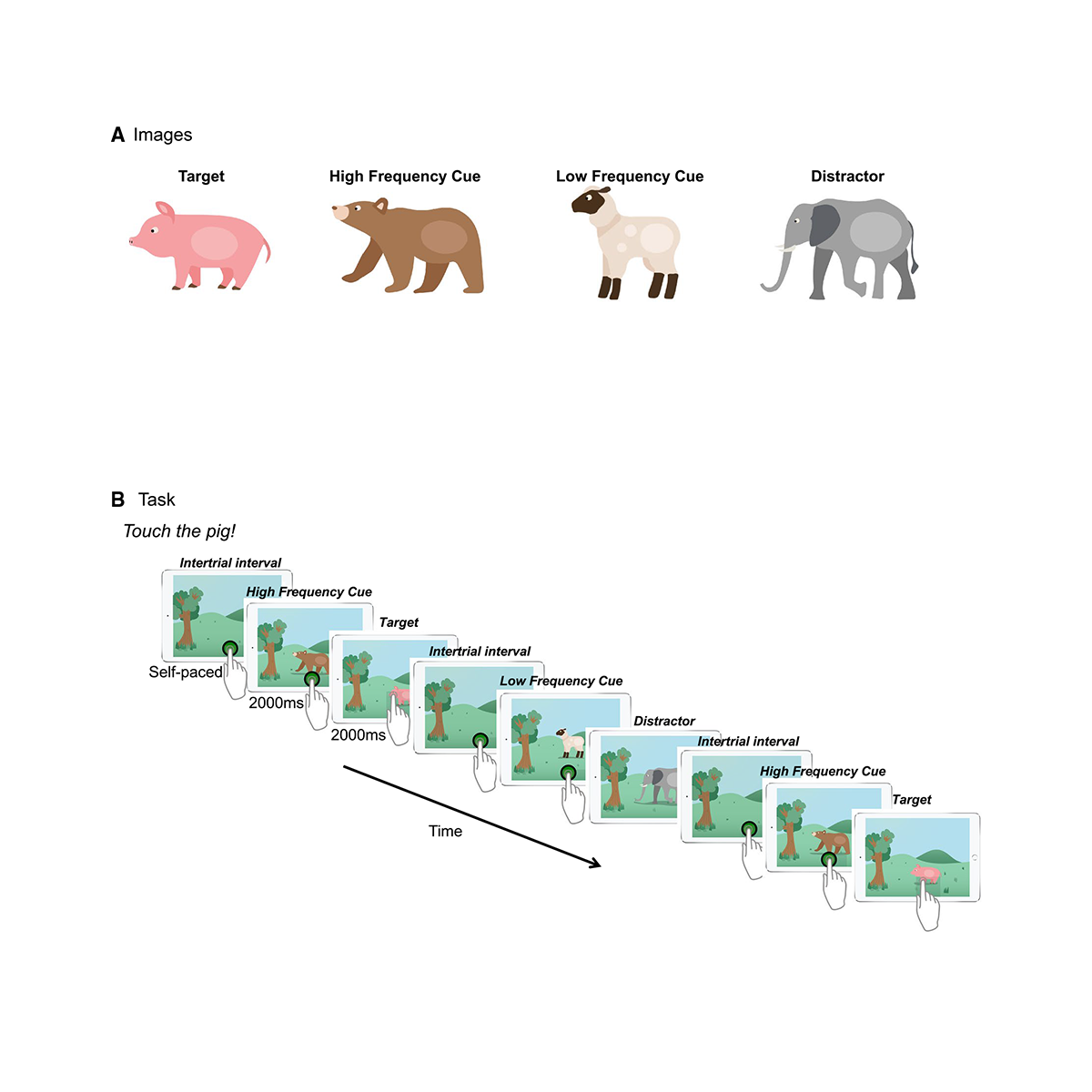
Statistical Learning is Associated with Autism Symptoms and Verbal Abilities in Young Children with Autism
Jones RM, Tarpey T, Hamo A, Carberry C, Brouwer G, Lord C.
Autism Dev Disord. 2018 Oct;48(10):3551-3561
Statistical learning-extracting regularities in the environment-may underlie complex social behavior. 124 children, 56 with autism and 68 typically developing, ages 2-8 years, completed a novel visual statistical learning task on an iPad. Averaged together, children with autism demonstrated less learning on the task compared to typically developing children. However, multivariate classification analyses characterized individual behavior patterns, and demonstrated a subset of children with autism had similar learning patterns to typically developing children and that subset of children had less severe autism symptoms. Therefore, statistically averaging data resulted in missing critical heterogeneity. Variability in statistical learning may help to understand differences in autism symptoms across individuals and could be used to tailor and inform treatment decisions.
Download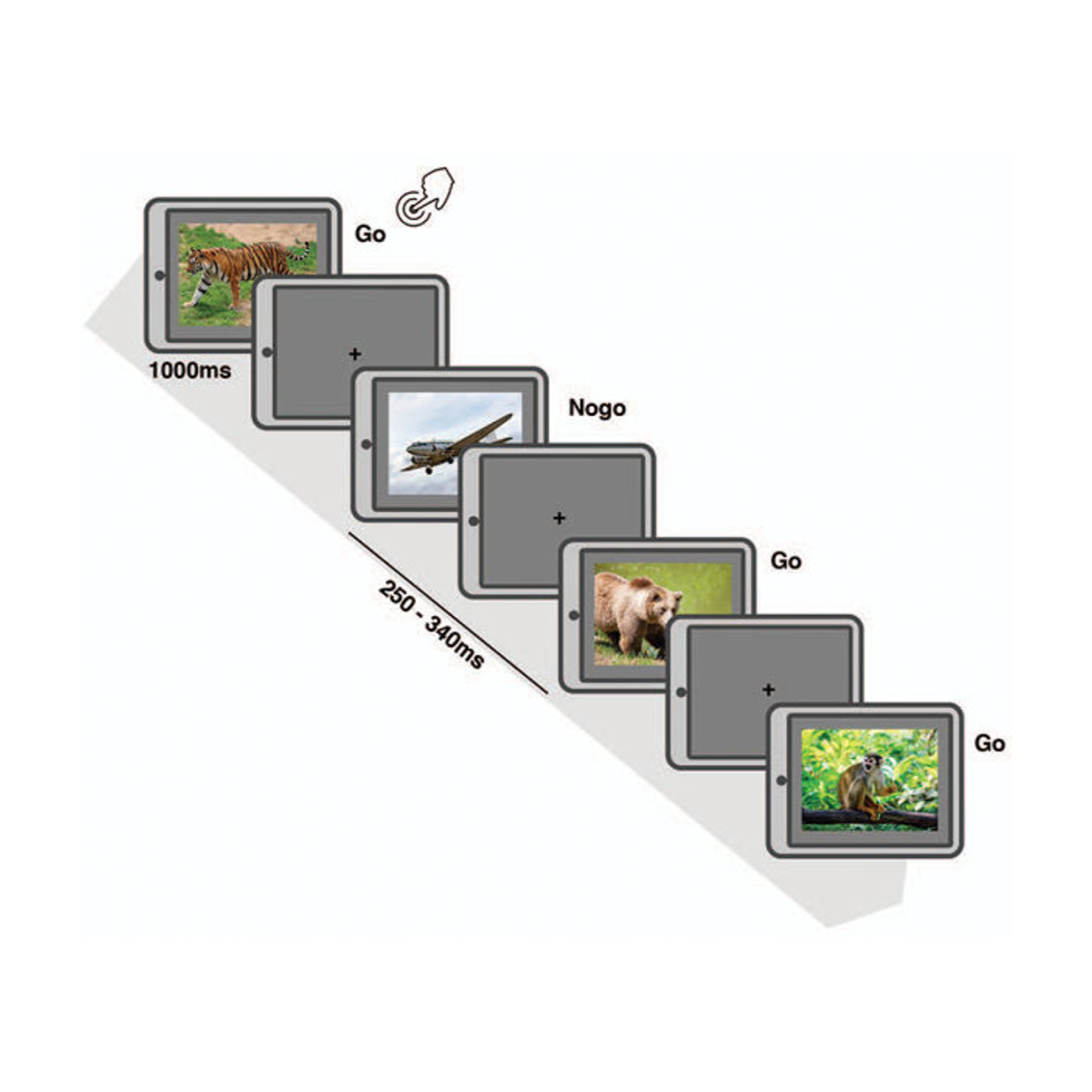
Rigidity coincides with reduced cognitive control to affective cues in children with autism
Bos DJ, Silverman MR, Ajodan EL, Martin C, Silver BM, Brouwer, J, Di Martino A, Jones RM.
J Abnorm Psychol. 2019 Jul;128(5):431-441
The present study tested whether salient affective cues would negatively influence cognitive control in children with and without autism spectrum disorder (ASD). One hundred children aged 6-12 years who were either typically developing or had ASD performed a novel go/no-go task to cues of their interest versus cues of noninterest. Linear mixed-effects (LME) models for hit rate, false alarms, and the sensitivity index d' were used to test for group differences. Caregivers completed the Repetitive Behavior Scale-Revised to test associations between repetitive behaviors and task performance. Children with ASD had reduced cognitive control toward their interests compared with typically developing children. Further, children with ASD showed reduced cognitive control to interests compared with noninterests, a pattern not observed in typically developing children. Decreased cognitive control toward interests was associated with higher insistence on sameness behavior in ASD, but there was no association between sameness behavior and cognitive control for noninterests. Together, children with ASD demonstrated decreased cognitive flexibility in the context of increased affective salience related to interests. These results provide a mechanism for how salient affective cues, such as interests, interfere with daily functioning and social communication in ASD. Further, the findings have broader clinical implications for understanding how affective cues can drive interactions between restricted patterns of behavior and cognitive control.
Download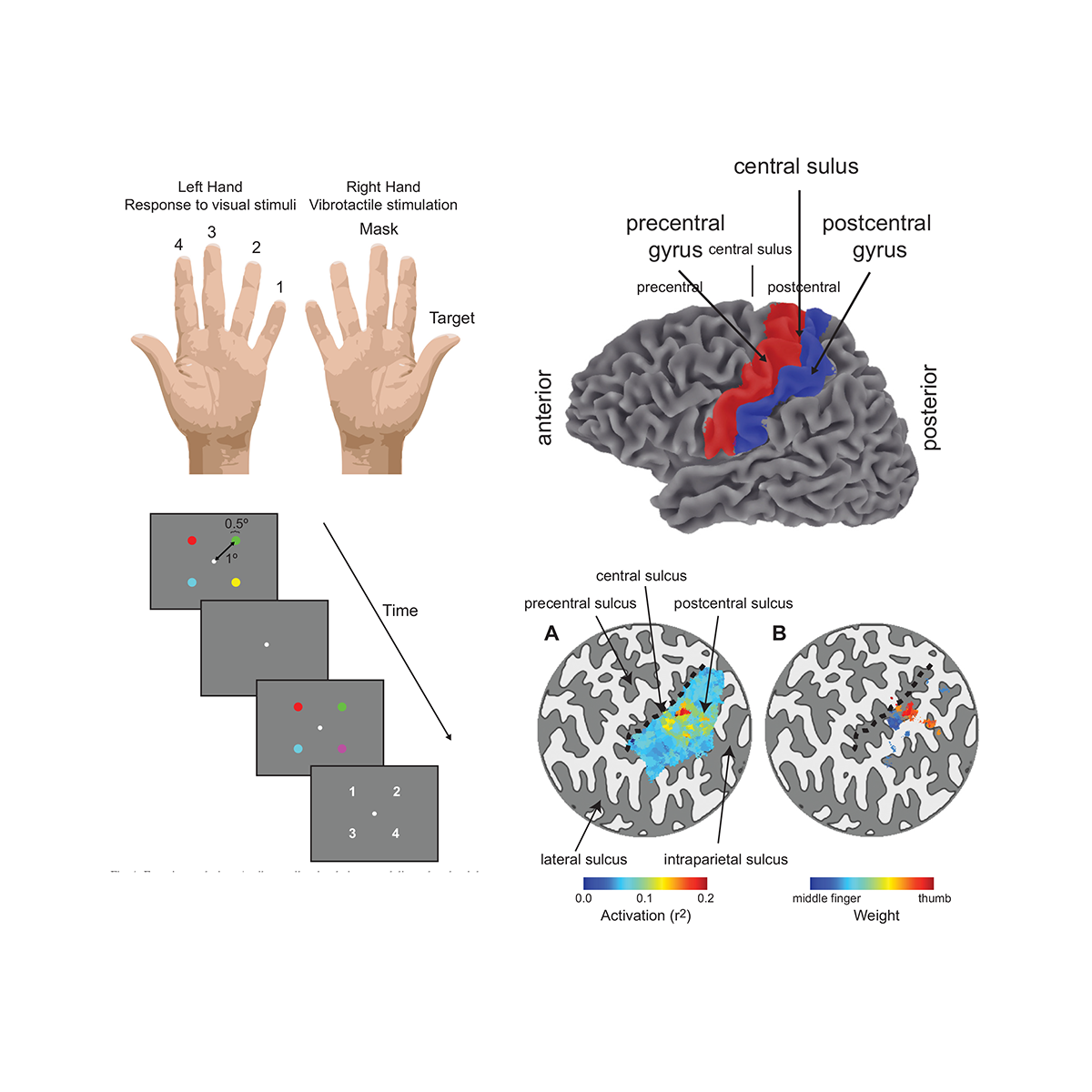
Normalization in human somatosensory cortex
Brouwer GJ, Arnedo V, Offen S, Heeger DJ, Grant AC.
J Neurophysiol. 2015 Nov;114(5):2588-99
Functional magnetic resonance imaging (fMRI) was used to measure activity in human somatosensory cortex and to test for cross-digit suppression. Subjects received stimulation (vibration of varying amplitudes) to the right thumb (target) with or without concurrent stimulation of the right middle finger (mask). Subjects were less sensitive to target stimulation (psychophysical detection thresholds were higher) when target and mask digits were stimulated concurrently compared with when the target was stimulated in isolation. fMRI voxels in a region of the left postcentral gyrus each responded when either digit was stimulated. A regression model (called a forward model) was used to separate the fMRI measurements from these voxels into two hypothetical channels, each of which responded selectively to only one of the two digits. For the channel tuned to the target digit, responses in the left postcentral gyrus increased with target stimulus amplitude but were suppressed by concurrent stimulation to the mask digit, evident as a shift in the gain of the response functions. For the channel tuned to the mask digit, a constant baseline response was evoked for all target amplitudes when the mask was absent and responses decreased with increasing target amplitude when the mask was concurrently presented. A computational model based on divisive normalization provided a good fit to the measurements for both mask-absent and target + mask stimulation. We conclude that the normalization model can explain cross-digit suppression in human somatosensory cortex, supporting the hypothesis that normalization is a canonical neural computation.
Download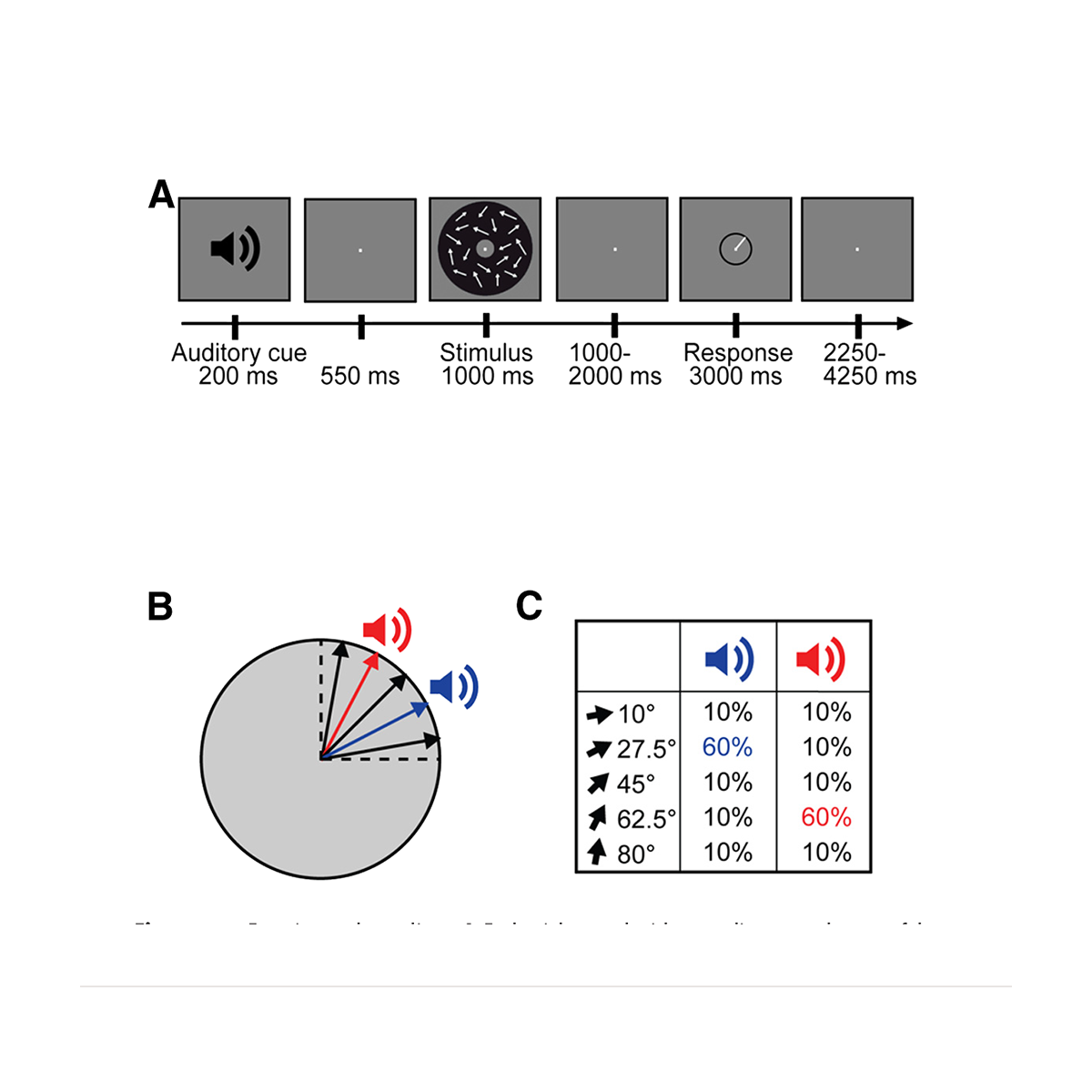
Prior expectations bias sensory representations in visual cortex
Kok P, Brouwer GJ, van Gerven MA, de Lange FP.
J Neurosci. 2013 Oct 9;33(41):16275-84
Perception is strongly influenced by expectations. Accordingly, perception has sometimes been cast as a process of inference, whereby sensory inputs are combined with prior knowledge. However, despite a wealth of behavioral literature supporting an account of perception as probabilistic inference, the neural mechanisms underlying this process remain largely unknown. One important question is whether top-down expectation biases stimulus representations in early sensory cortex, i.e., whether the integration of prior knowledge and bottom-up inputs is already observable at the earliest levels of sensory processing. Alternatively, early sensory processing may be unaffected by top-down expectations, and integration of prior knowledge and bottom-up input may take place in downstream association areas that are proposed to be involved in perceptual decision-making. Here, we implicitly manipulated human subjects' prior expectations about visual motion stimuli, and probed the effects on both perception and sensory representations in visual cortex. To this end, we measured neural activity noninvasively using functional magnetic resonance imaging, and applied a forward modeling approach to reconstruct the motion direction of the perceived stimuli from the signal in visual cortex. Our results show that top-down expectations bias representations in visual cortex, demonstrating that the integration of prior information and sensory input is reflected at the earliest stages of sensory processing.
Download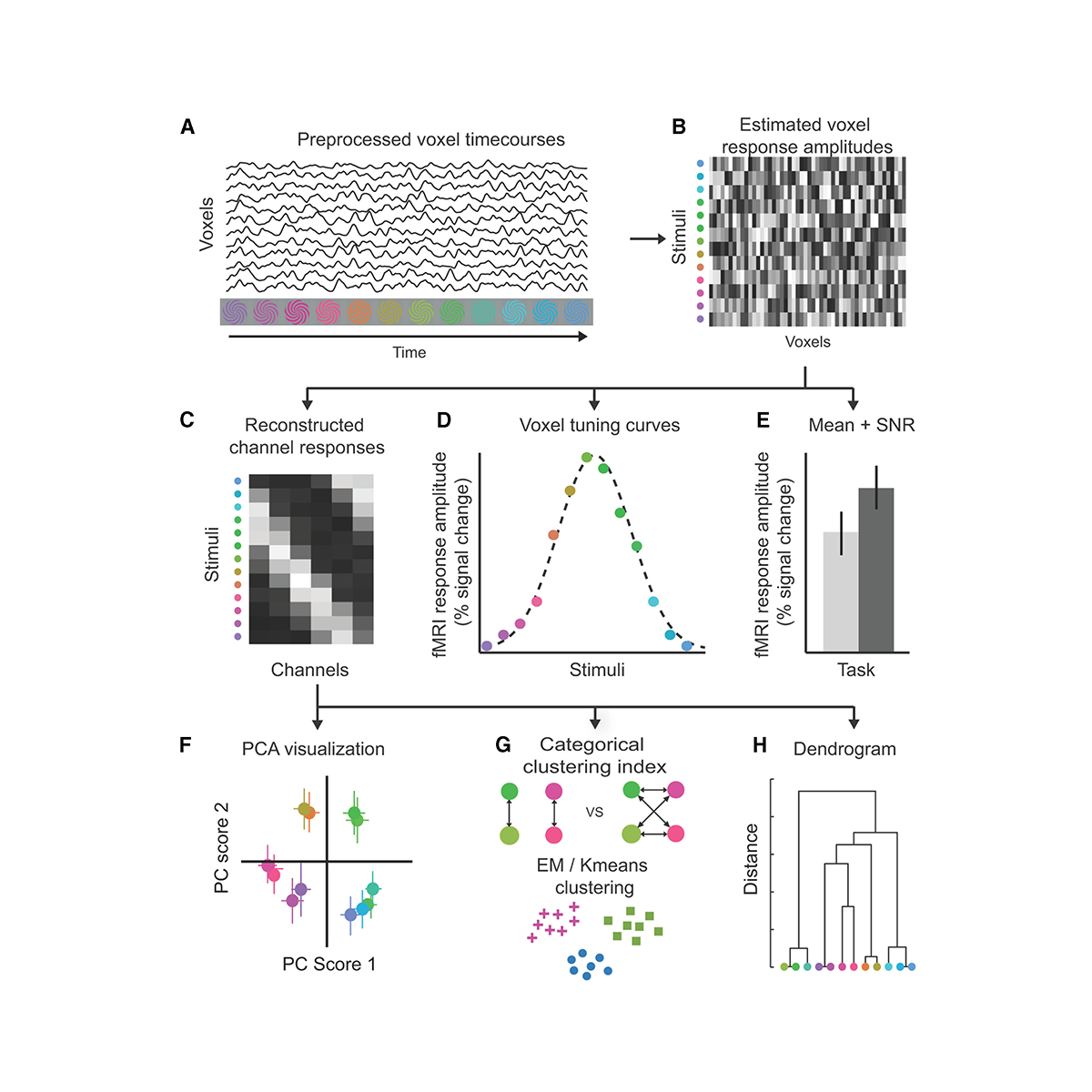
Categorical clustering of the neural representation of color
Brouwer GJ, Heeger DJ.
J Neurosci. 2013 Oct 9;33(41):16275-84
Cortical activity was measured with functional magnetic resonance imaging (fMRI) while human subjects viewed 12 stimulus colors and performed either a color-naming or diverted attention task. A forward model was used to extract lower dimensional neural color spaces from the high-dimensional fMRI responses. The neural color spaces in two visual areas, human ventral V4 (V4v) and VO1, exhibited clustering (greater similarity between activity patterns evoked by stimulus colors within a perceptual category, compared to between-category colors) for the color-naming task, but not for the diverted attention task. Response amplitudes and signal-to-noise ratios were higher in most visual cortical areas for color naming compared to diverted attention. But only in V4v and VO1 did the cortical representation of color change to a categorical color space. A model is presented that induces such a categorical representation by changing the response gains of subpopulations of color-selective neurons.
Download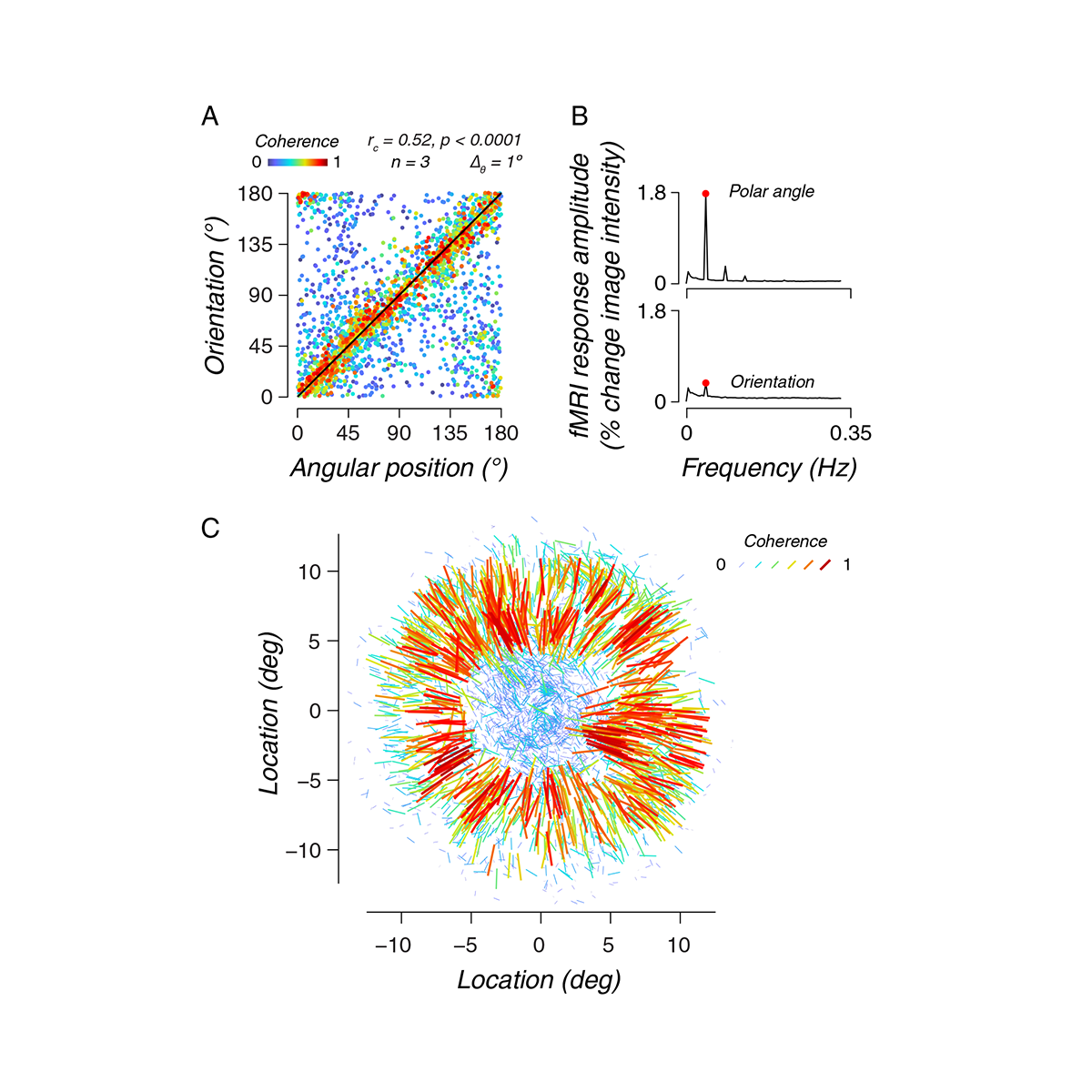
Orientation decoding depends on maps, not columns
Freeman J, Brouwer GJ, Heeger DJ, Merriam EP.
J Neurosci. 2011 Mar 30;31(13):4792-804
The representation of orientation in primary visual cortex (V1) has been examined at a fine spatial scale corresponding to the columnar architecture. We present functional magnetic resonance imaging (fMRI) measurements providing evidence for a topographic map of orientation preference in human V1 at a much coarser scale, in register with the angular-position component of the retinotopic map of V1. This coarse-scale orientation map provides a parsimonious explanation for why multivariate pattern analysis methods succeed in decoding stimulus orientation from fMRI measurements, challenging the widely held assumption that decoding results reflect sampling of spatial irregularities in the fine-scale columnar architecture. Decoding stimulus attributes and cognitive states from fMRI measurements has proven useful for a number of applications, but our results demonstrate that the interpretation cannot assume decoding reflects or exploits columnar organization.
Download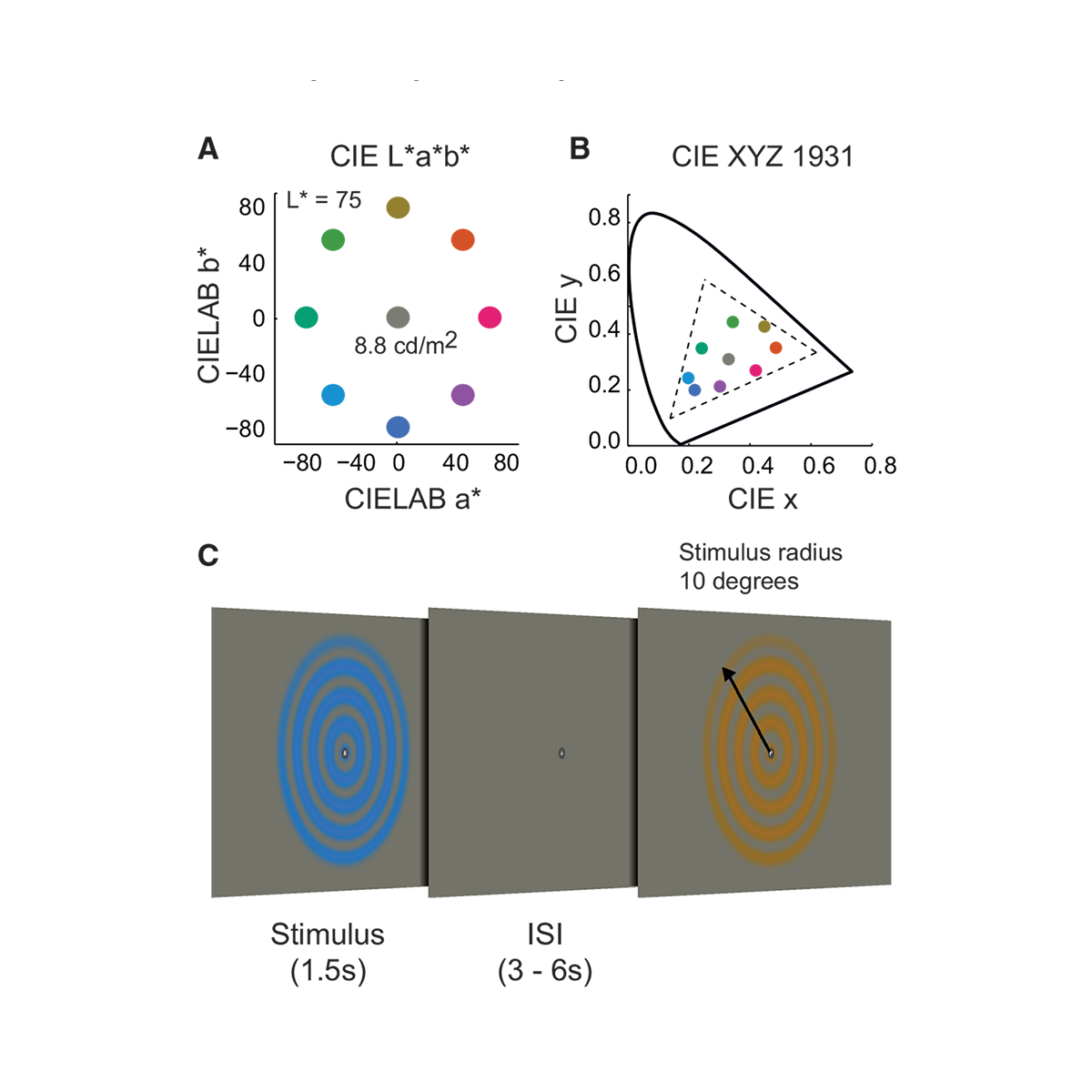
Decoding and reconstructing color from responses in human visual cortex
Brouwer GJ, Heeger DJ.
J Neurosci. 2009 Nov 4;29(44):13992-4003
How is color represented by spatially distributed patterns of activity in visual cortex? Functional magnetic resonance imaging responses to several stimulus colors were analyzed with multivariate techniques: conventional pattern classification, a forward model of idealized color tuning, and principal component analysis (PCA). Stimulus color was accurately decoded from activity in V1, V2, V3, V4, and VO1 but not LO1, LO2, V3A/B, or MT+. The conventional classifier and forward model yielded similar accuracies, but the forward model (unlike the classifier) also reliably reconstructed novel stimulus colors not used to train (specify parameters of) the model. The mean responses, averaged across voxels in each visual area, were not reliably distinguishable for the different stimulus colors. Hence, each stimulus color was associated with a unique spatially distributed pattern of activity, presumably reflecting the color selectivity of cortical neurons. Using PCA, a color space was derived from the covariation, across voxels, in the responses to different colors. In V4 and VO1, the first two principal component scores (main source of variation) of the responses revealed a progression through perceptual color space, with perceptually similar colors evoking the most similar responses. This was not the case for any of the other visual cortical areas, including V1, although decoding was most accurate in V1. This dissociation implies a transformation from the color representation in V1 to reflect perceptual color space in V4 and VO1.
Download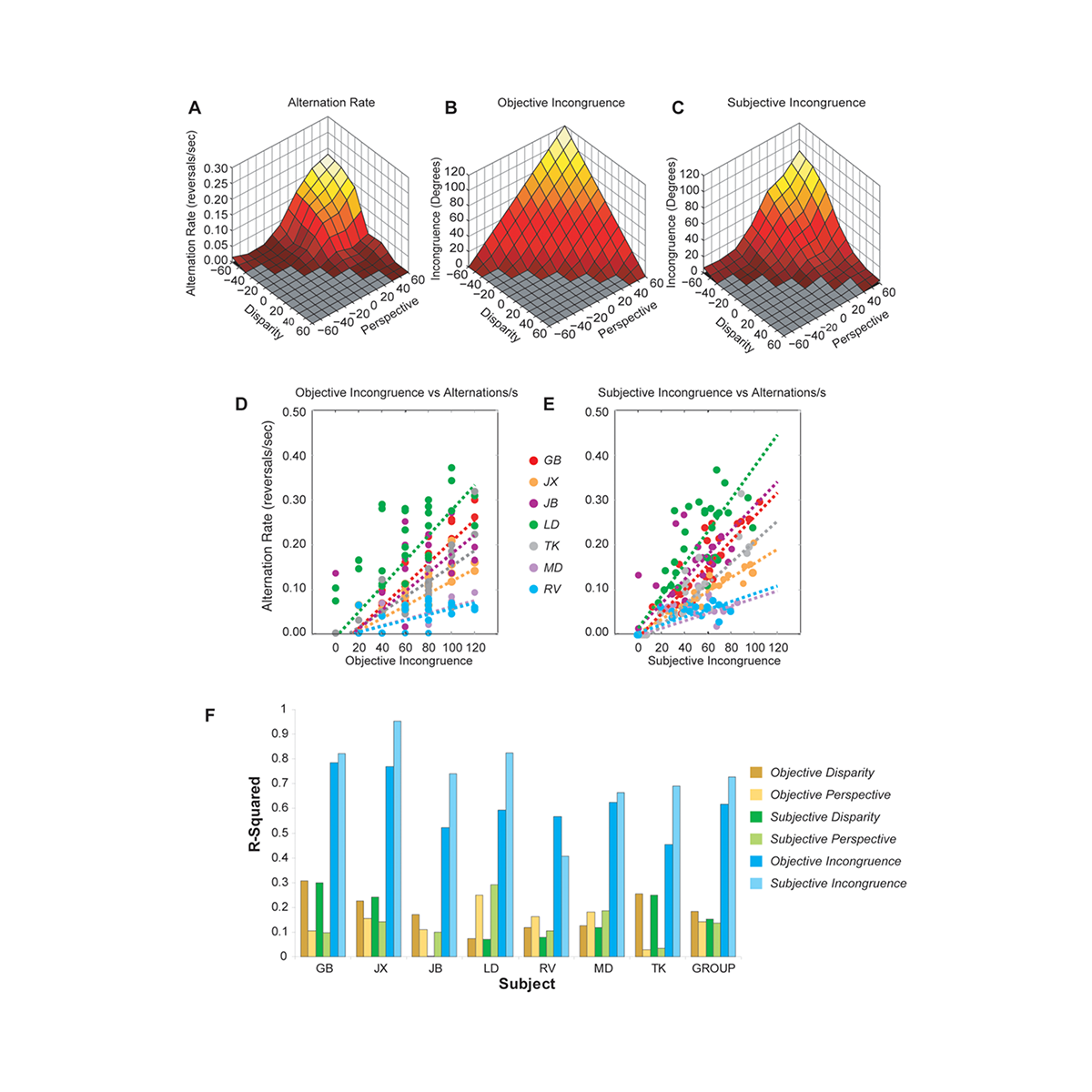
Perceptual incongruence influences bistability and cortical activation
Brouwer GJ, Tong F, Hagoort P, van Ee R.
PLoS One. 2009;4(3):e5056
We employed a parametric psychophysical design in combination with functional--> imaging to examine the influence of metric changes in perceptual incongruence on perceptual alternation rates and cortical responses. Subjects viewed a bistable stimulus defined by incongruent depth cues; bistability resulted from incongruence between binocular disparity and monocular perspective cues that specify different slants (slant rivalry). Psychophysical results revealed that perceptual alternation rates were positively correlated with the degree of perceived incongruence. Functional imaging revealed systematic increases in activity that paralleled the psychophysical results within anterior intraparietal sulcus, prior to the onset of perceptual alternations. We suggest that this cortical activity predicts the frequency of subsequent alternations, implying a putative causal role for these areas in initiating bistable perception. In contrast, areas implicated in form and depth processing (LOC and V3A) were sensitive to the degree of slant, but failed to show increases in activity when these cues were in conflict.
Download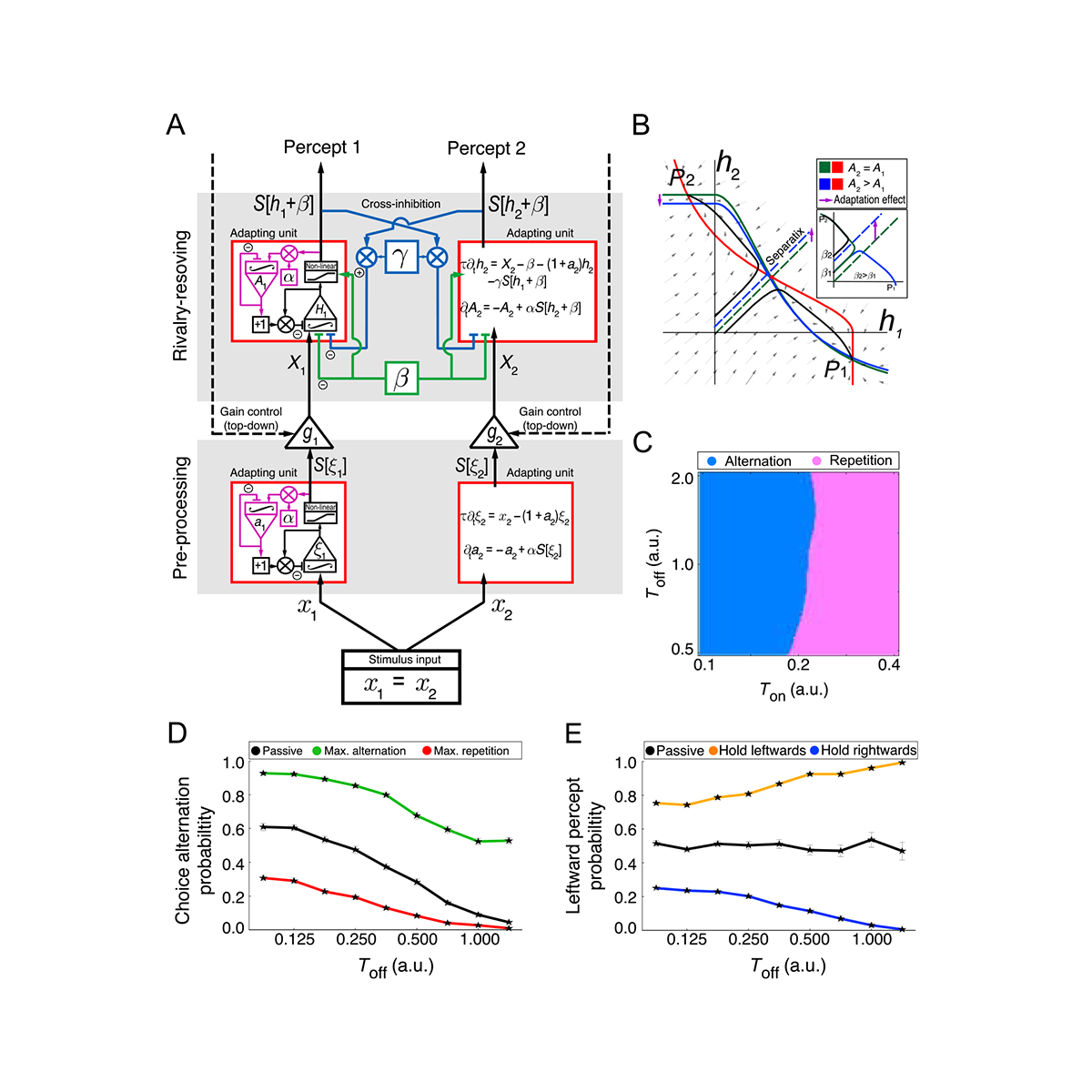
Early interactions between neuronal adaptation and voluntary control determine-
Klink PC, van Ee R, Nijs MM, Brouwer GJ, Noest AJ, van Wezel RJ.
J Vis. 2008 May 30;8(5):16.1-18
At the onset of bistable stimuli, the brain needs to choose which of the competing perceptual interpretations will first reach awareness. Stimulus manipulations and cognitive control both influence this choice process, but the underlying mechanisms and interactions remain poorly understood. Using intermittent presentation of bistable visual stimuli, we demonstrate that short interruptions cause perceptual reversals upon the next presentation, whereas longer interstimulus intervals stabilize the percept. Top-down voluntary control biases this process but does not override the timing dependencies. Extending a recently introduced low-level neural model, we demonstrate that percept-choice dynamics in bistable vision can be fully understood with interactions in early neural processing stages. Our model includes adaptive neural processing preceding a rivalry resolution stage with cross-inhibition, adaptation, and an interaction of the adaptation levels with a neural baseline. Most importantly, our findings suggest that top-down attentional control over bistable stimuli interacts with low-level mechanisms at early levels of sensory processing before perceptual conflicts are resolved and perceptual choices about bistable stimuli are made.
Download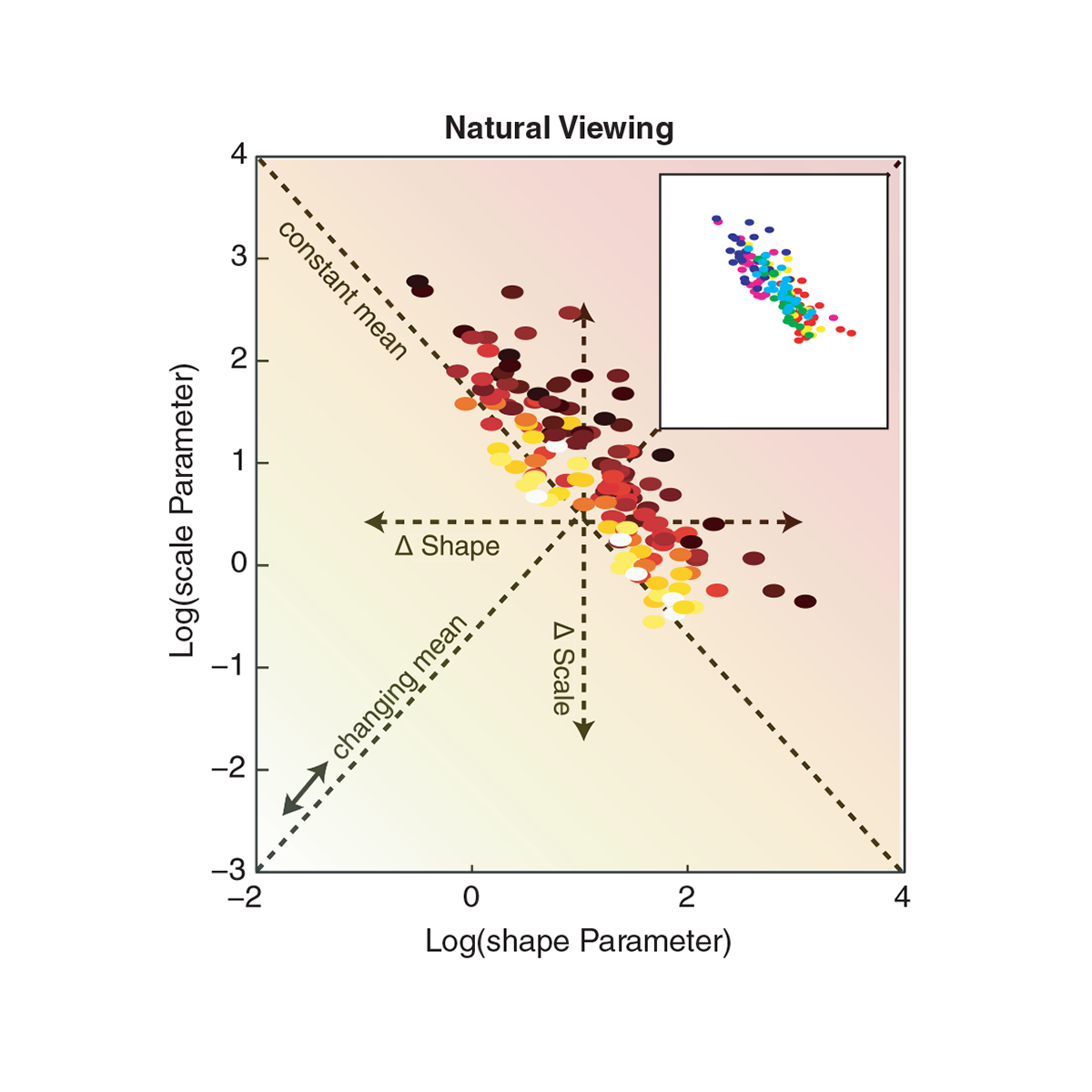
Endogenous influences on perceptual bistability depend on exogenous stimulus characteristics
Brouwer GJ, van Ee R.
Vision Res. 2006 Oct;46(20):3393-402
We investigated the influence of changing physical parameters and task on bistable perception of an ambiguously rotating sphere (SFM). Increasing dot-density and velocity decreased the duration of perceptual phases during both passive viewing and voluntary control exertion. Our main finding is that voluntary control of perception depends on the physical parameters constituting the stimulus. This dependency places important constraints on the mechanisms mediating voluntary control as these mechanisms cannot operate independently of stimulus characteristics. In addition, local asymmetries in dot-densities can trigger alternations towards the most salient direction, which is not necessarily associated with largest number of dots: competition between perceptual interpretations during SFM appears to occur between surface-based representations rather than between individual elements. Finally, we show that voluntary control remains effective, even when attentive tracking of individual stimulus elements is no longer possible.
Download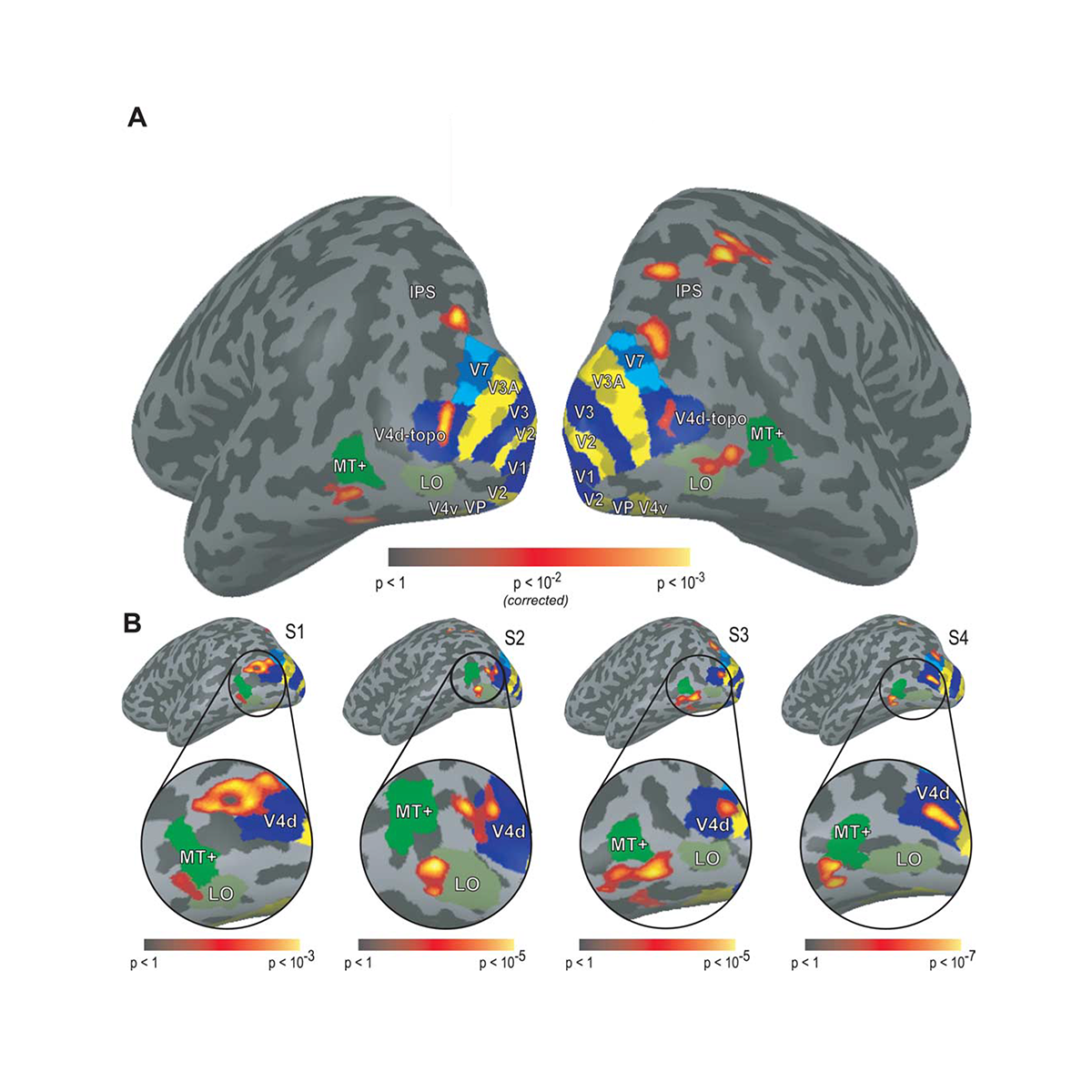
Activation in visual cortex correlates with the awareness of stereoscopic depth
Brouwer GJ, van Ee R, Schwarzbach J.
J Neurosci. 2005 Nov 9;25(45):10403-13
Using event-related functional magnetic resonance imaging, we studied the activation correlating with the awareness of stereoscopic depth using a bistable slanted surface (slant rivalry). Bistability resulted from incongruence between two slant-defining cues: binocular disparity and monocular perspective. The stimulus was perceived as alternating between the perspective-dominated percept (monocular depth) and the disparity-dominated percept (stereopsis), while sensory input remained constant, enabling us to study changes in awareness of depth associated with either cue. Transient activation relating to perceptual alternations was found bilaterally in the caudal part of the intraparietal sulcus, in the right-hemispheric anterior intraparietal sulcus, within visual area V4d-topo, and inferior to area MT+. Transient activation correlating specifically with alternations toward the disparity-dominated percept was found in a number of visual areas, including dorsal visual areas V3A, V7, and V4d-topo and visual areas MT+ and lateral occipital complex. No activation was found for alternations toward the perspective-dominated percept. Our results show that of all visual areas responsive to disparity-defined depth, V4d-topo shows the most robust signal changes correlating with the instigation of stereoscopic depth awareness (stereopsis).
Download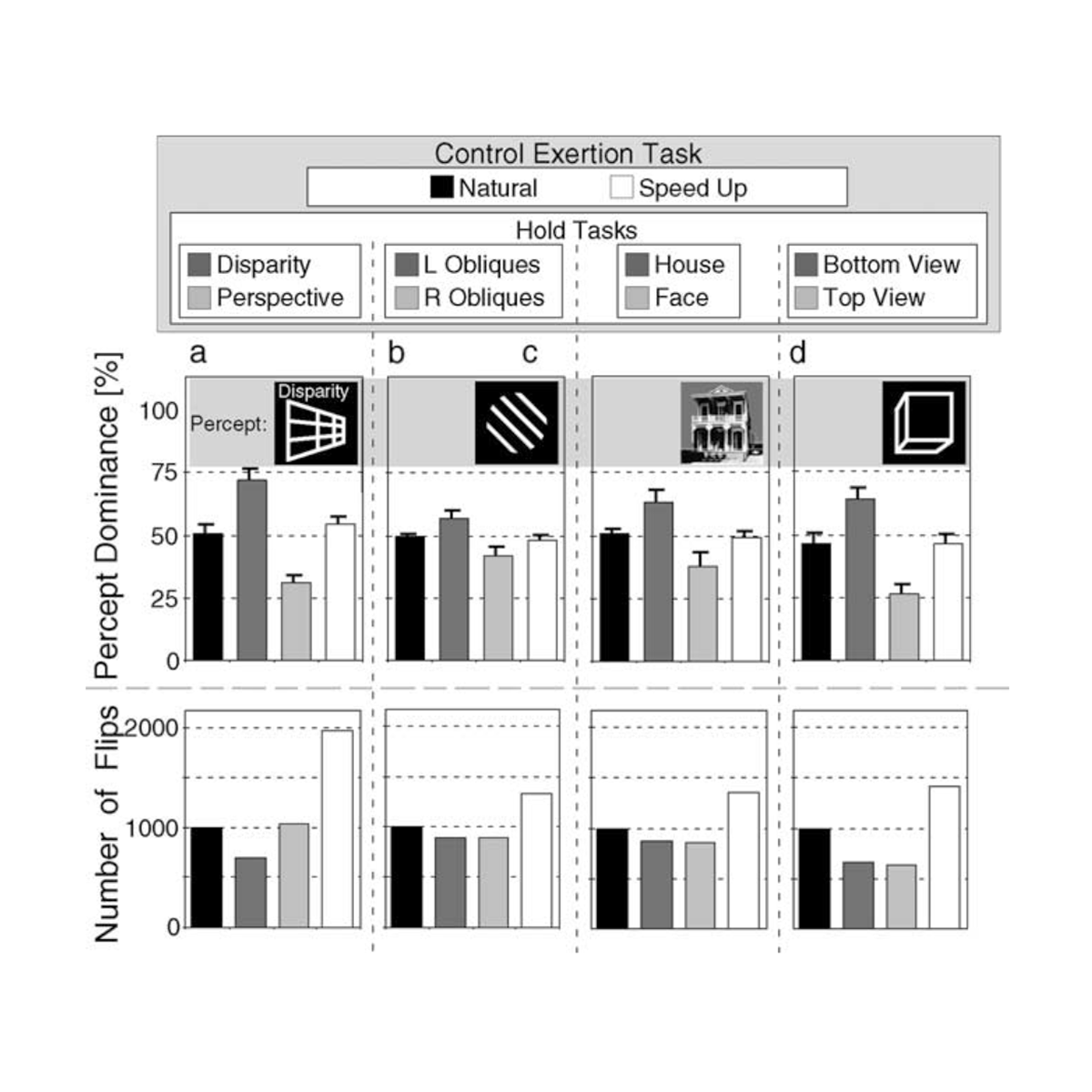
Voluntary control and the dynamics of perceptual bi-stability
van Ee R, van Dam LC, Brouwer GJ.
J Neurosci. 2005 Nov 9;25(45):10403-13
Voluntary control and conscious perception seem to be related: when we are confronted with ambiguous images we are in some cases and to some extent able to voluntarily select a percept. However, to date voluntary control has not been used in neurophysiological studies on the correlates of conscious perception, presumably because the dynamic of perceptual reversals was not suitable. We exposed the visual system to four ambiguous stimuli that instigate bi-stable perception: slant rivalry, orthogonal grating rivalry, house-face rivalry, and Necker cube rivalry. In the preceding companion paper [van Ee, R. (2005). Dynamics of perceptual bi-stability for stereoscopic slant rivalry and a comparison with grating, house-face, and Necker cube rivalry. Vision Research] we focussed on the temporal dynamics of the perceptual reversals. Here we examined the role of voluntary control in the dynamics of perceptual reversals. We asked subjects to attempt to hold percepts and to speed-up the perceptual reversals. The investigations across the four stimuli revealed qualitative similarities concerning the influence of voluntary control on the temporal dynamics of perceptual reversals. We also found differences. In comparison to the other rivalry stimuli, slant rivalry exhibits: (1) relatively long percept durations; (2) a relatively clear role of voluntary control in modifying the percept durations. We advocate that these aspects, alongside with its metrical (quantitative) aspects, potentially make slant rivalry an interesting tool in studying the neural underpinnings of visual awareness.
Download